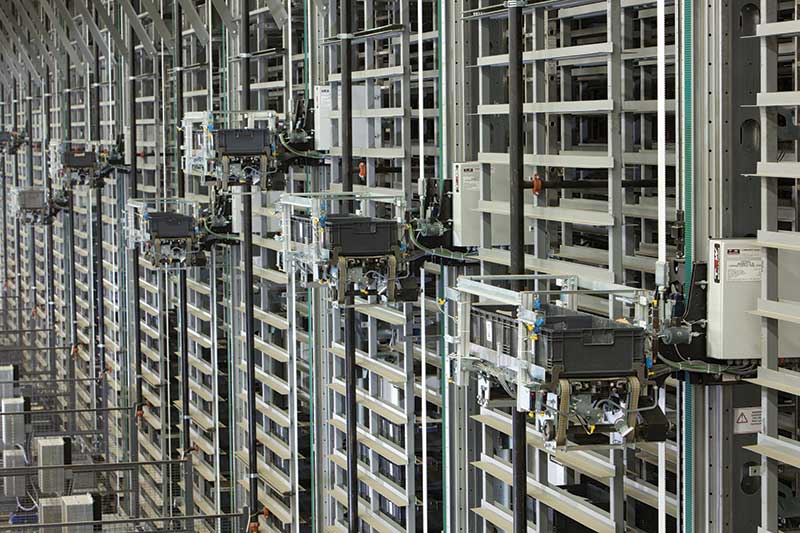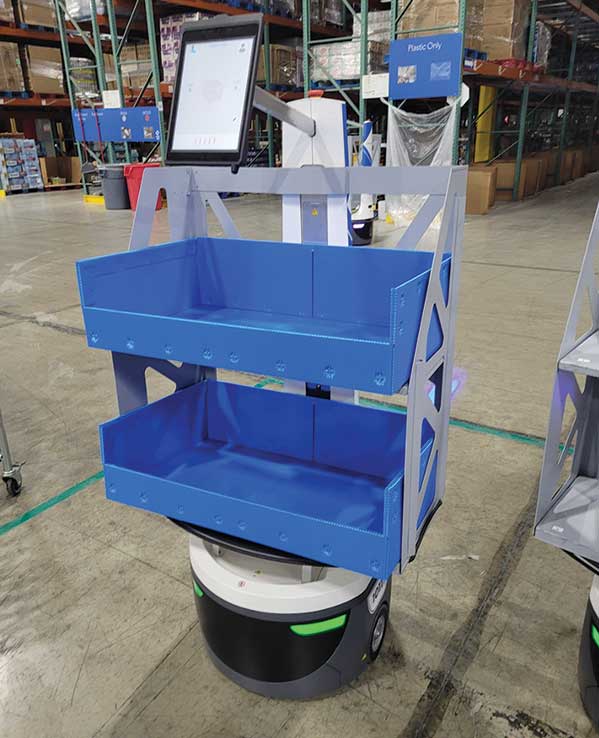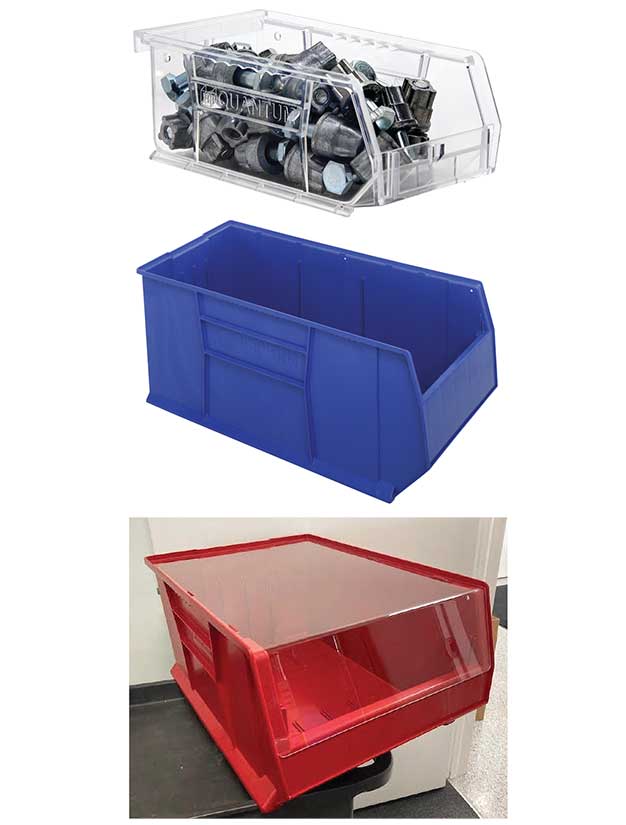What’s New in Totes, Bins and Containers?
From the relatively mundane to the truly innovative, totes, bins and containers are continuously receiving upgrades to make them better suited to the job at hand.

The only thing the world has more of than totes, bins and containers is stuff to put in them. Furthermore, that stuff is constantly changing, as are the ways you and others want to stage, store and transport it all.
Just ask Ed Granger, sales manager at Quantum Storage. He tells the story of an airline components manufacturer that has had in place for five years roughly 2,000 open top bins measuring 30 x 11 x 10 inches.
All is good with the bins, says Granger. They may even last just short of forever. However, the manufacturer now wants to cover the contents.
The solution: a clear acrylic lid. Granger explains the lids are not attached to the bin. They simply rest on top.
That’s pretty simple and basic by any standard. But more importantly, it does what is required. And perhaps just as importantly, the lids are actually a retrofit to the bins, further extending their useful life.
As Flexcon’s sales specialist Cynthia Pecoraro explains, simple and basic are two guiding forces in tote, bin and container selection these days. Other key words, she says, are cost effective, long life and customizable.
And as you already suspect, suppliers can satisfy all of those requirements all day, every day. Here’s a look at some of the trends they’re focused on right now. They range from the simplest of bins in manual warehouses to totes for large automated storage systems and autonomous mobile robots all the way to bulk containers.

The story in automation
Since automation appears to be on everyone’s mind, let’s start there.
Andrea Nottestad, ORBIS’ senior product manager, spends a lot of time with containers for automation ranging from conveyors and robotics to traditional automated storage and retrieval systems (AS/RS), especially in the retail industry.
As she points out, there’s a lot of flux here. Quite simply, order fulfillment in retailer distribution centers is in flux as the mix of orders for brick-and-mortar stores and e-commerce orders evolves. Different stages of the process demand different containers, says Nottestad.
In fact, container design is increasingly a function of the tasks and activities associated with the container, adds Nottestad. That’s an important shift from the past when tasks more or less adapted to the container design rather than the other way around. And it’s happening from deep within the warehouse to the final mile of delivery.
Critical considerations here include not just the container cube, but velocity of containers both within the four walls and from facility to facility, explains Nottestad. These requirements determine the footprint of the container as well as its degree of durability. But there’s more to it.
Nottestad points to ORBIS’ line called AROS, or automated reusable optimized solutions. A range of tote sizes, says Nottestad, maximizes high cubic density by matching the totes to the various cubes it interacts with, especially in the AS/RS.
Size matters in a different way if those totes also travel to the retail location aboard over-the-road trucks. For instance, one design is sized to load 928 totes on a truck. Another is sized for 1,200 totes. What matters most in both cases is cubing out the truck to maximize the number of totes without leaving space unused, explains Nottestad.
Returning those totes to the DC also matters. The totes collapse easily and are stackable to maximize the cube on the return trip.
When in use, wide hopper doors allow easy access to the tote’s contents and maximize density in picking aisles at the DC or the retail location.
By the way, a different line of ORBIS totes, the XPP, offers ease of picking, staging and delivering orders curbside at the retail location. This is just another instance of tote design tailored for a specific application.
Moving on from there, Flexcon’s Pecoraro talks about one of the more unusual tailored solutions specifically for autonomous mobile robots (AMRs).
“An AMR is basically a tray that moves around a warehouse. The trick is to make it even more valuable by adding a stable container on top of that tray to carry a range of items,” explains Pecoraro.

She goes on to say that Flexcon’s bot tote is 37 inches tall and subdivided into different shelves with a total of as many as 12 cells. The tote fits into the AMR’s tray and is held in place with zip ties in the back, says Pecoraro.
The open-faced cells allow easy visibility for order pickers as well as ease of access to the parts each holds. Typically, each cell holds items for a single order as the AMR moves around the facility and workers pick into the designated cells.
While the totes come in six standard configurations, they can be modified or completely redesigned to accommodate a broad range of items that may change over time.
The bot tote is currently used on AMRs from Locus Robots, Amazon Robots and Fetch Robotics. More than 10,000 of the bot totes are in use today. They can also be mounted on automatic guided vehicles.
Small bins, big results
At the other end of the warehouse operational spectrum are bins and totes for manual operations. Even here, suppliers are constantly being pushed to come up with new solutions that accommodate future materials handling operations.
That said, don’t assume that “new solutions” necessarily require innovation. And that’s not a negative. The objective for all totes, bins and containers is to get the job done with the simplest design and lowest cost.
Flexcon’s line of warehouse bins fit that description, says Ken Beckerman, president. The most popular of these open face, stackable bins range in size from 12 x 12 x 10 inches to 48 x 12 x 12 inches. Beckerman says roughly 20 sizes fit in between those two book ends. Flexcon sells nearly 1 million of these totes annually.
Made of die-cut, corrugated polypropylene, the bins are typically stacked on the floor, pallets and shelving. The bins are available in several colors and can be treated for flame retardance as well as electro-static dissipation.
Stacking six high is common. And even within a single configuration, the totes can be used for different activities in the DC.
It’s that versatility, says Beckerman, that makes them so easy to adapt to a range of operations. E-commerce is a leading application. One facility currently uses about 20,000 of the warehouse bins.
Over at Quantum Storage, Granger says a new launch are crystal clear bins. Made from crystal polystyrene, they are perfectly clear, allowing easy visibility of the contents. The clarity is so great the bins sell for a 25% to 30% premium over standard clear bins, says Granger.
“These bins are so clear they look like pharmaceutical grade, and so are a great bin for pharmaceuticals, health care and lab applications,” says Granger.
Another new product from Quantum is the Hulk container. These, says Granger, are 24-inch, stackable, heavy-duty bins made of injection molded polypropylene.
In keeping with its name, the bin features heavy-duty front, back and side grips and anti-slide locks to prevent shifting. High temperature resistance means they are autoclavable to 250°F and resistant to extreme cold. Basically, says Granger, the bins can take a beating and still hold up to such abuse.
The latest in bulk bins
Durability is the centerpiece of bulk bins in general. And recent developments from both ORBIS and Schaefer are automotive bound, especially for electric vehicle production.

Recently, Schaefer received a design and innovation award from the Reusable Packaging Association for its GROUNDER bulk bin. The base 48 x 45 x 45-inch bin protects electronic parts from accidental electrostatic discharges that could harm the parts in the bin. It’s available in two footprints and 10 heights.
This bulk bin joins Schaefer’s established line of electrostatic discharge (ESD) containers and dunnage, says Andy Schumacher, vice president of packaging.
“Each top-load bulk bin has a latched drop door that enables additional ergonomics for loading and unloading,” adds Schumacher.
It’s important to note a range of parts get shipped in bulk bins, explains Chad Mosley, ORBIS product manager. They range from wiring harnesses to automotive components, especially ones with Class A surfaces that require dunnage protection.
ORBIS’ BulkPak HDMP bins can be delivered directly to the assembly line for immediate parts presentation to workers. On the return, these knock down, 48 x 45-inch bins collapse and stack for loading on over-the-road trailers. Up to 84 bins fit on a truckload inbound and 252 bins on the return.
In addition, see the Packaging Corner story of this issue for details on how General Motors has reduced waste and carbon emissions using recycled materials as much as possible.
So, there you have it for the latest in totes, bins and containers. Millions upon millions of them stage, store and transport so much of what travels through the supply chain. And there will probably be another new idea tomorrow, too.

Article Topics
Locus Robotics News & Resources
Autonomous mobile robots (AMRs) on a mission Up close and personal with mind twisting special purpose robots Locus Robotics showcases warehouse fulfillment and automation innovations What’s new in totes, bins and containers? Locus Robotics passes 2 billion units picked milestone Locus Robotics breaks ground for new global headquarters Savant WMS and Locus Robotics partner on integration More Locus RoboticsLatest in Materials Handling
Geek+ and System Teknik deploy PopPick solution for pharmacy group Med24.dk Beckhoff USA opens new office in Austin, Texas Manhattan Associates selects TeamViewer as partner for warehouse vision picking ASME Foundation wins grant for technical workforce development The (Not So) Secret Weapons: How Key Cabinets and Asset Management Lockers Are Changing Supply Chain Operations MODEX C-Suite Interview with Harold Vanasse: The perfect blend of automation and sustainability Consultant and industry leader John M. Hill passes on at age 86 More Materials HandlingAbout the Author
Subscribe to Materials Handling Magazine

Find out what the world's most innovative companies are doing to improve productivity in their plants and distribution centers.
Start your FREE subscription today.
April 2024 Modern Materials Handling

Latest Resources










